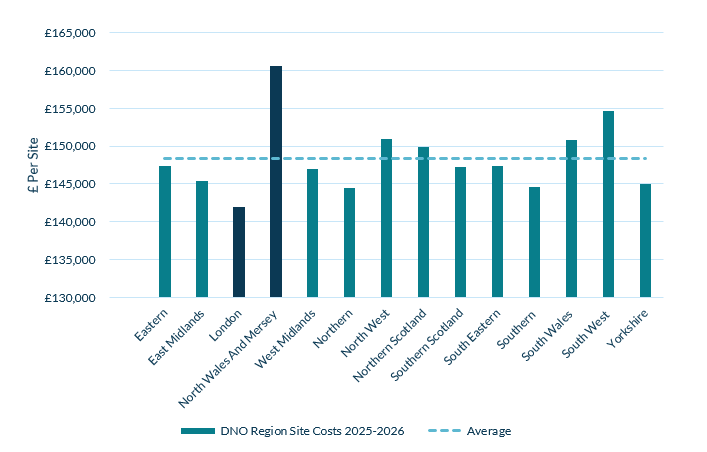Understanding the makeup of energy bills and engaging proactively with the market could be key to managing these financial pressures.
Dr Craig Lowrey Principal Consultant
Small and Medium sized Enterprises (SMEs) in North Wales and Merseyside, are forecast to pay 13% more in electricity bills next financial year than their counterparts in London – equating to nearly £19,000 more in bills on an average like-for-like basis.
The data from Cornwall Insight’s Business Energy Cost Forecast predicts an average SME1 in the Wales and Merseyside region, such as a professional services business, or a medium sized office, will pay £161,000 a year for electricity costs, more than any other region in the country. Their costs sit at around 8% higher than the predicted countrywide average of £148,000 a year, and 13% higher than the capital at £142,000 a year. The disparity in bills between the two regions, which is rising from the current 7.5%, is due to North Wales and Merseyside having higher non-wholesale costs – also known as Third Party Charges (TPCs). The increasing gap will put more pressure on already struggling rural SMEs, particularly concerning after recent figures show unemployment in Wales remain 1% higher than the UK average2.
Third Party Charges differ from region to region. They include all electricity costs outside the price of the fuel itself - the wholesale price - and typically make up around 60% of a business electricity bill. They are broadly split into network charges like distribution and transmission costs, and policy costs such as funding for government initiatives like renewable energy.
While policy costs are relatively uniform across the country, the regional variance is almost exclusively down to the level and structure of network charges between the areas, with these being set for each of the 14 regions of the British electricity market by regulated price control for each of the Distribution Network Operators (DNOs). These are dependent on a range of factors including terrain, population density and grid maintenance and upkeep costs, while transmission costs – as charged by the National Energy System Operator (NESO) on a regulated basis – also have regional differences.
While the government is consulting on the introduction of zonal wholesale pricing, it is important to remember that some costs are already locational.
Many SMEs, especially in rural areas, have seen profits fall over the past few years as inflation and rising costs take their toll on sales and eat into profit margins. A recent survey3 showed 72% of UK businesses expect high energy prices to negatively impact profits over the next two years, and 81% expect to raise prices in response to energy bills.
With many businesses' electricity contracts up for renewal in April, numerous companies will be seeking to switch suppliers in hopes of securing better deals amidst the high costs.
Figure 1: Implied Delivered Electricity Price per SME site in each Distribution Network Operator Region - Real 2025-26 inclusive of VAT (exc. Metering charges)

Source: Cornwall Insight – Business Energy Cost Forecast
Dr Craig Lowrey, Principal Consultant at Cornwall Insight, said:
“These forecasts highlight the stark regional disparities in electricity costs for SMEs. Businesses are struggling with high energy costs across the country, but the steep third-party charges faced by those in particular regions only serves to highlight the problems faced by those businesses that could already be operating on razor-thin margins.
“As energy prices continue to weigh on businesses, it is crucial for SMEs to stay informed about their energy options. With many contracts up for renewal in April, now is the time for businesses to review their energy strategies, explore switching opportunities, and consider efficiency measures to help ease rising costs. Understanding the makeup of energy bills and engaging proactively with the market could be key to managing these financial pressures. With the government looking at the prospect of regional wholesale electricity costs as part of its market reform programme, it is clear that a holistic view of the energy costs faced by businesses is needed.”
Reference:
- A typical SME site in Cornwall Insight’s Business Energy Cost Forecast uses 627,598kWh of energy a year
- Labour Market Overview: March 2025 – Welsh Government
- PWC – 5 February 2025
Notes to Editors
For more information, please contact: Verity Sinclair at v.sinclair@cornwall-insight.com
To link to our website, please use: https://www.cornwall-insight.com/
Copyright disclaimer for commercial use of the press releases:
The content of the press release, including but not limited to text, data, images, and graphics, is the sole property of Cornwall Insight and is protected by UK copyright law. Any redistribution or reproduction of part or all of the content in any form for commercial use is prohibited without the prior written consent of Cornwall Insight.
Media Use Exemption: The information included in this press release may be used by members of the media for news reporting purposes only. Any other commercial use of this information is prohibited without the prior written consent of Cornwall Insight. All non-media use is prohibited, including redistribution, reproduction, or modification of our content in any form for commercial purposes, and requires prior written consent. Please contact: enquiries@cornwall-insight.com
About the Cornwall Insight Group Cornwall Insight is a leading provider of research, analysis, consulting and training to businesses and stakeholders engaged in the Great British, Irish and Australian energy markets. To support our customers, we leverage a powerful combination of analytical capability, a detailed appreciation of regulation codes and policy frameworks, and a practical understanding of how markets function.
